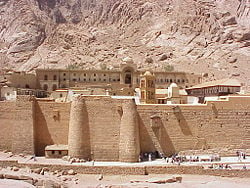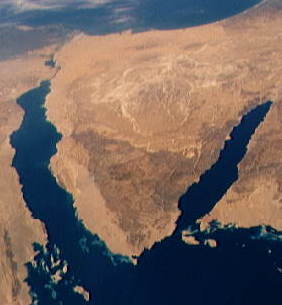Sinai Peninsula
The Sinai Peninsula is a triangle-shaped peninsula located in Egypt that has an area of about 60,000 square kilometers between the Mediterranean Sea (to the north) and Red Sea (to the south). Its land borders are the Suez Canal to the west and the Israeli-Egyptian border to the northeast. The Sinai Peninsula is in Southwest Asia (also called West Asia - the more geographically accurate term for the Middle East) while the rest of Egypt is in North Africa. For geopolitical purposes, the Sinai is often considered part of Africa.
The Sinai is almost entirely desert, but is settled along the Sabah coast at Taba (near the Israeli town of Eilat), where there is a hotel and casino. Southwards from Taba ,along the coast, lie the cities of Nuweiba, Dahab and Sharm el-Sheikh. The Sinai is also settled on the north coast near the Gaza Strip at El-Arish. Bedoins carry on their pastoral herding lifestyle in the bordering desert areas with some living in stationary homes in outlying towns and cities near more populated areas.
The eastern boundary of the peninsula is a geological fault zone known as the Great Rift Valley, which can be seen from the upper Jordan River valley, extending southward through the Red Sea into Africa.
History
The earliest recognizable habitation of the Sinai was by the Monitu when it was called Mafkat or Country of Turquoise. From the time of the First dynasty or before, the Egyptians mined turquoise in Sinai at Wadi Maghareh and Serabit el-Khadim. They were operated on a seasonal basis, off and on, for thousands of years. Modern attempts to exploit the deposits have been unprofitable.
The desert of the Sinai is particularly fascinating for those interested in some of the oldest civilizations chronicled in the Bible. The great patriarchs of biblical history, like Abraham and Moses, all lived in or passed through the area. The stories in Exodus of Moses leading the Hebrew people out of Egypt to wander 40 years in the desert, the manna falling from heaven and Moses receiving the Ten Commandments are the inspiration behind many a pilgrimage.
Southern Sinai's Gebel Musa ("Mountain of Moses") is spiritually and historically significant for Christians, Jews, and Muslims. In the 4th century AD, Coptic Christians came to the mountain and founded a small church at the spot where it was believed God spoke to Moses in the form of the burning bush. Later on, the site evolved into St. Catherine's Monastery, revered by many as one of the most sacred places on Earth. The monastery has survived many groups of desert marauders over the past 1500 years. Muslims left it intact even during the Crusades because it honors one of Islam's most important prophets. Third century hermits sought refuge and seclusion in the heights of the mountains around the monastery. Currently Greek Orthodox monks occupy the monastery and protect it's substantial collection of Byzantine art.
In 1844 the Codex Sinaiticus, one of the oldest manuscripts of the New Testament was found near St. Catherine's monastery.
There are many archeological sites of interest in this desert. One site revealed nawamis, roofed rooms which are thought to have been burial chambers belonging to prehistoric peoples. The Nabateans who inhabited this desert in the 2nd and 3rd centuries left behind ornate carved rose-colored rock facades at the city of Petra.
Modern history
Until the early 20th century, Sinai was under the control of the Ottoman Empire. In 1906 it became part of then British-controlled Egypt, when the Turkish government yielded to British pressure to hand over the peninsula. The border imposed by the British runs in an almost straight line from Rafah on the Mediterranean Sea shore to Taba on the Gulf of Aqaba. This line has served as the eastern border of Sinai ever since, and is now the international border between Israel and Egypt.
In 1948, Egyptian forces passed through Sinai on their way to invade the newly-created state of Israel based on a United Nations mandate dividing the land between the Jews and the Christian and Muslim inhabitants. During the 1948 Arab-Israeli War, Israeli forces entered the north-eastern corner of Sinai, but withdrew shortly after, following British and American pressure. Under the terms of the 1949 Armistice Agreement, Sinai, together with the Gaza Strip, remained under Egyptian control, although parts of it were demilitarized.
In 1956, Egypt used its control of Sinai to impose a blockade on the Israeli port of Eilat. Following this, Israeli forces, aided by Britain and France (which sought to regain control over the Suez Canal) invaded Sinai, and in just a few days took control of the entire peninsula. (see Suez Crisis). Several months later, Israel withdrew its forces from Sinai, following strong American and Russian pressure. Following this, the United Nations Emergency Force, (UNEF), was stationed in Sinai to prevent any military occupation of the Sinai.
In 1967, Egypt reinforced its military presence in Sinai, renewed the blockade on Eilat, and on May 16 ordered the UNEF out of Sinai. In the following Six-Day War, the Egyptian army was defeated, and Israel took control of the entire peninsula. The Suez Canal, whose east bank was now controlled by Israel, was closed.
In the 1973 Yom Kippur War, Egyptian forces built pontoon bridges to cross the Suez Canal and stormed the supposedly impregnable Barlev Line to gain control of most of the Eastern Bank. Some held positions and others were pushed back across the Suez Canal, the war ending with some of each side's forces on both sides of the canal. As part of the subsequent Sinai Disengagement Agreements, Israel withdrew from west of the canal and pulled out of an additional strip in the western Sinai — while Egyptians held positions in Sinai — allowing for the eventual re-opening of the canal under Egyptian control.
In 1979 Israel and Egypt signed a Peace Treaty, in which Israel agreed to transfer all control over Sinai to Egypt. Subsequently, Israel pulled out of Sinai in several stages, ending in 1982. The Israeli pull-out involved the destruction of several Israeli settlements including the town of Yamit in north-eastern Sinai.
Present

.
The Sinai Peninsula is currently divided among several governorates, or provinces, of Egyptian administration. The southern portion of the Sinai is called Janub Sina' in Arabic, literally "Sinai South." South Sinai has its capital in At Tur. The northern portion is named Shamal Sina', or "Sinai North". North Sinai has its capital at Al Arish. the other three governates converge on the Suez Canal, including Al Isma'iliyah on its southern end and crosses into Egypt-proper. In the center is As Suways, literally "the Suez;" and Bur Sa'id lies in the north with its capital at Port Said.
The Sinai is sparsely populated. Approximately 66,500 live in Janub Sina' and 314,000 live in Shamal Sina'. Port Said itself has a population of roughly 500,000. Portions of the populations of Al Isma'iliyah and As Suways live in Sinai, while the rest live on the western side of the Suez Canal in Egypt proper. The combined population of these two governorates is roughly 1.3 million (only a part of that population live in the Sinai, while the rest live on the western side of the Suez.
The economics of the region consist of tourism, limestone quarrying and oil drilling near the Gulf of Suez. Bedoins eek out a living through pastoral herding along the edges of the desert.
Flora and Fauna
There are 3 main geographical regions of the Sinai Peninsula. The northern region consists of flat, uniform vast sand and limestone hills along the Mediterranean. This region becomes a vast elevated plateau of the central area known as the Al Tih and is scarcely inhabited. To the south are highlands of granite and volcanic rock formations and escarpments that slope into the Red Sea and the Gulf of Aqaba.
Although the general conditions of the Sinai peninsula are dry and hot with sparse vegetation, it is not without life. Wildlife is specially adapted to the climate with many species of snakes and mammals color-camouflaged to the earthy tones of the desert.
Some of the mammal species that exist are leopard, ibex and the Golden Spiney Mouse. There are several species of snakes and most are very poisonous: the Carpet Viper, Black Cobra, and Horned Viper are common. Lizzards like the blue-headed Agama stand out against the neutral shades of desert sand and rocks. There is an abundance of bird life particularly near the coastlines where many migratory species pass.
The coral reefs along the Sinai coastline are rated among the best in the world for snorkeling and diving and the Red Sea has an abundance and diversity of tropical marine wildlife. The Red Sea is named for the Red Sea Hills a low range of mountains along the Red Sea Coast.
Other References and credits
- Egypt Sinai Peninsula: Geography. http://www.photius.com/countries/egypt/geography/egypt_geography_sinai_peninsula.html
- Egyptian Monuments: Sinai. http://www.egyptsites.co.uk/deserts/sinai.html
- Sinai Adventures Magazine. http://www.allsinai.info/sites/fauna.htm
- The Sinai Peninsula and Red Sea. Globe Media, Ltd. http://www.wordtravels.com/Travelguide/Countries/Egypt/Regions/The+Sinai+Peninsula+and+the+Red+Sea
- Sinai on the Red Sea. Sinai Network. 2006 http://www.sinai4you.com/sina
- The Suez/Sinai War (1956), The History Guy, Roger A. Lee and History Guy Media http://www.historyguy.com/suez_war_1956.html
- Walking the Bible, Bruce Feiler. Harper Perennial (2005) ISBN 0060838639
External links
Credits
New World Encyclopedia writers and editors rewrote and completed the Wikipedia article in accordance with New World Encyclopedia standards. This article abides by terms of the Creative Commons CC-by-sa 3.0 License (CC-by-sa), which may be used and disseminated with proper attribution. Credit is due under the terms of this license that can reference both the New World Encyclopedia contributors and the selfless volunteer contributors of the Wikimedia Foundation. To cite this article click here for a list of acceptable citing formats.The history of earlier contributions by wikipedians is accessible to researchers here:
The history of this article since it was imported to New World Encyclopedia:
Note: Some restrictions may apply to use of individual images which are separately licensed.
